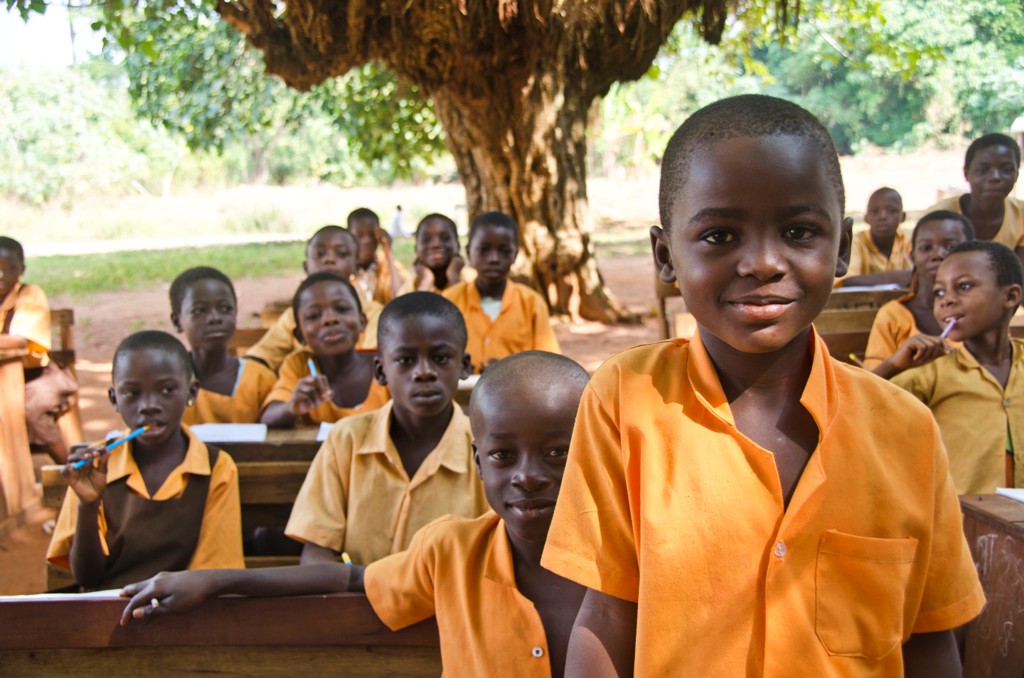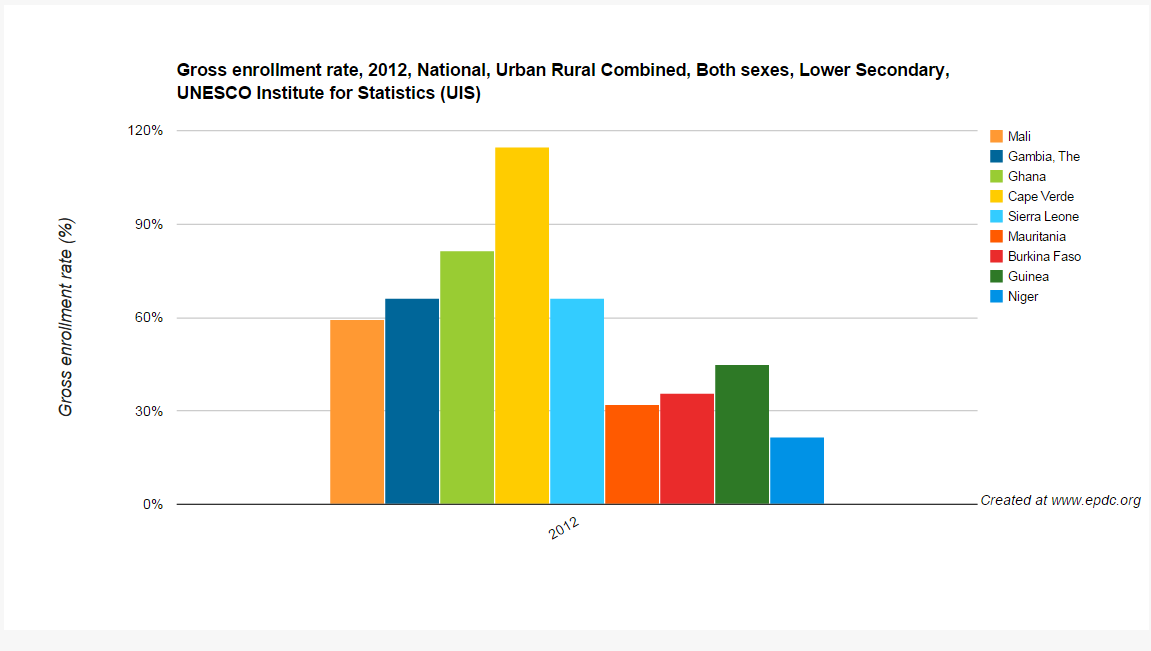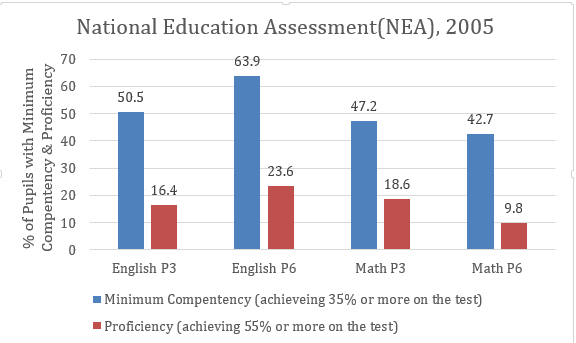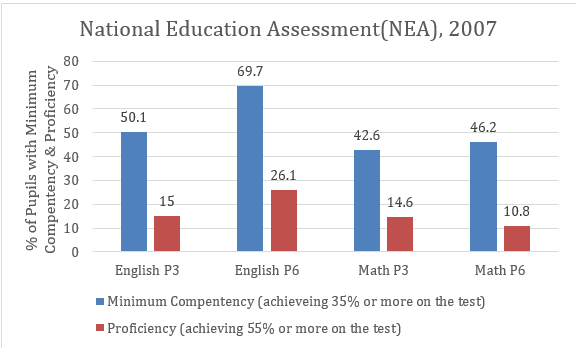You are here
EPDC Spotlight on Ghana

This is the latest post in our Country Spotlight series, where we highlight a different country and the resources we offer, such as data, country profiles, research or other tools that users have available to them through the website. In this post, Maxine Wang highlights the data resources we have for Ghana.
Ghana is a country located in West Africa and bordered by the Gulf of Guinea and Atlantic Ocean to the south. With the highest per capita income in the sub-region of western Africa, Ghana has outpaced most neighboring countries in economic growth and development. In 2014, Ghana was designated as a lower middle income country by World Bank. In 2013, Ghana had 129,599 teachers in primary school, 93,797 in lower secondary school and 40,641 in upper secondary school. Female teachers accounted for 37.9%, 25.3% and 21.7% in each school cycle, respectively.
The Education system in Ghana is structured as a 6-3-4 cycle and primary school has an official entry age of six. In the 2008 Education Act, as the legal outcome of the 2007 Nation Education Reform Programme, 2 years of Kindergarten were incorporated into Basic Education, which is compulsory and consists of 11 years of schooling from pre-school to lower secondary. In kindergarten and the lower grades of primary school, English and Ghanaian languages jointly serve as medium of instruction. In terms of national assessments, students sit for the Basic Education Certificate Examination at the end of grade 9, and the Senior School Certificate Examination at the end of secondary school.
Ghana and Millennium Development Goals (MDGs)
The country’s progress on meeting the MDGs on universal primary education is reflected in its high school participation. In primary education, Ghana achieved 100% gross enrollment rate (GER) in 2007 and has kept it well above 100% most of the time since then. To guarantee universal access to primary school, incentive schemes such as school feeding programmes, capitation grants and free school uniforms were key factors contributing to the progress in universal schooling.
Rising GER at the secondary level is showing that Ghana is leading the way toward universal lower secondary education and positioned itself satisfactorily among West African countries in secondary school participation. In 2012, UIS data shows that Ghana achieved an 81.6 percent gross lower secondary enrollment rate, compared to some West African countries such as Niger and Burkina Faso struggling to maintain GER above 30 (Figure 1). The ongoing improvement of secondary access is also seen in the high rate of transition to lower secondary. EPDC projections for Ghana estimate the transition rate will be nearly 100% with no gender disparity by 2025.
Figure 1 Lower secondary school gross enrollment rate by West African countries
Education data and Challenges in Ghana
With optimistic expectations for universal schooling, education inequality still remains an issue in Ghana. Figure 3 indicates that Northern and Western areas have a noticeable disadvantage in completing lower secondary education. In addition, poverty and slow economic development appear to coincide with the geographical disparity. Across ten sub-national areas in Ghana, Upper East, Upper West, Northern and Volta are all below the national average (69.9) in lower secondary completion rates and are also the regions with the highest working poor and the biggest proportion of self-employment and homemaker population (Figure 2). This trend suggests a relationship between education attainment and quality of employment, and also implies that targeted education programs should be implemented to address education inequality and reduce poverty.
Figure 2 Extreme Working Poverty Rate and Lower Secondary Completion Rate, Ghana
Moreover, beyond the encouraging achievement in primary school participation is weak academic performance. Figures 3 and 4 show overall weak proficiency in English and mathematics in P3 and P6 pupils without much improvement taken place between 2005 and 2007 in the National Education Assessment (NEA). In 2005 and 2007, less than 70% of P3 and P6 pupils demonstrated the minimum competency (achieving 35% or more on the test;) and less than 25% of pupils in English assessment and 19% pupils in math assessment demonstrated proficiency (achieving 55% or more on the test). Such results are in part why the government of Ghana enlisted the support of USAID and other local and international partners, including FHI 360, to implement a project to assist the country in improving learning outcomes for children in the lower grades.
Also in 2011, TIMSS data indicates that nearly 80% of pupils in P8 were below the lowest performance benchmark in mathematic assessment, implying a huge challenge in achieving and managing quality education.
Figure 3 learning outcome in NEA, 2005
Data source: MOE (2007) National Education Assessment (NEA)
Figure 4 learning outcome in NEA, 2007
Data source: MOE (2007) National Education Assessment (NEA)
Policy Shift in 2010
On the way to provide a quality and affordable education system, Ghana’s new focus in Education Strategic Plan 2010 to 2020 (ESP) was to adopt a cost-effective approach to make the best use of resources in the education sector. Unlike other Sub-Saharan African countries that have struggled with overcrowded classrooms in recent years, overstaffing is common at both the primary and secondary levels and indicates that educational resources have not been optimized. In 2008-2009, about one-eighth of primary schools, mostly in rural areas, had Pupil Teacher Ratios (PTR) at 15 to 1 and nearly 40% of primary schools had PTR less than 30 to 1. At the lower secondary level, 94% of districts were overstaffed thus decreasing PTR to 17.4 in 2008 (24 is the OECD average). To address the consequence of inadequate PTR, such as high unit costs per pupil, Ghana merged schools with enrollment below 30 and introduced multi-grade teaching by providing training programs for teachers in 2010
Additionally, Public-private partnerships (PPPs) in education were adopted by Ghana as a policy alternative. PPPs entail pooling of resources and capacity from the public and private sectors to achieve outcomes of effective and efficient education programming beyond what either party can achieve acting alone. Implemented as a cost-cutting strategy, PPP tactics include government support to primary and lower secondary schools by providing non-salary inputs such as textbooks and in service training. Also, in return for private support to Technical Vocational Education and Training (TVET), tax holidays and tax exemptions are offered by government.
Considering education inequality needs to be addressed while prioritizing cost-cutting strategies, decentralization in education was also a principal point in ESP. Mainly managed by the Ministry of Education, basic education and secondary education will be taken over gradually by local governments and to some extent the schools themselves such as School Management Committees (SMC) and Boards of Governors (BoG). It was perceived that the local governments in districts are best placed to arrange adequate distributions of education resources given their familiarity with local conditions. Hence, through education management and delivery devolved to the local level, education inequality, like geographic disparity or specific needs in regions, can be addressed effectively by accountable local governments and institutions.
EPDC’s Resources
Among other data sources, unique EPDC data collections for Ghana include administrative data from the Statistical Service (2006-2010) and Ministry of Education (2011), household survey data from DHS (1993, 1998, 2002, 2003, 2007, 2008, 2009), LSS (1998), MICS (2006), indicators derived from UIS data, and learning outcomes data including TIMSS (2003, 2007, 2011).




Add new comment